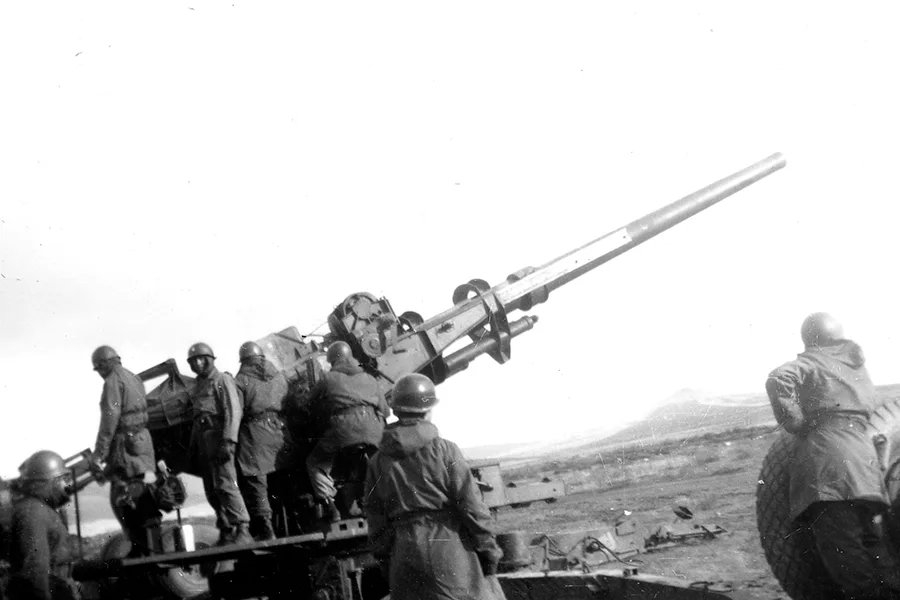
Home » Camp Hanford built memories while protecting plutonium production
Camp Hanford built memories while protecting plutonium production

December 14, 2022
Seventy years ago, the soldiers of Camp Hanford built a giant Santa Claus and placed him, his sleigh and his reindeer on the main building of the post.
It was a cheerful addition to Camp Hanford in Richland, which served as headquarters for the Army’s 5th Anti-Aircraft Group, which was charged with protecting the 586-square-mile Hanford complex and its plutonium production reactors.
In 1952, Hanford was one of the Army’s most desolate stateside posts. Santa was a welcome symbol of Christmas and fulfilled one commander’s promise to make life better for the soldiers living amid the sage and sand of Eastern Washington.
Hanford played a critical role in the U.S. national defense mission. It produced 60% of the plutonium needed for America’s nuclear arsenal.
Eight nuclear reactors operated throughout all or part of Camp Hanford’s decade-long tenure.
In the uncertainty of the Cold War, the camp defended them against possible aerial attack.
In all, some 5,000 troops reported to Camp Hanford to serve with the 5th, and four attached gun battalions, the 83rd, 501st, 518th and the 519th.
The earliest arrivals lived in pup tents and laid out sandbags, quickly establishing the air defense system.
Col. Onto P. Bragen, then commanding officer of Camp Hanford, started 1952 by promising his men that he “would do everything in my power to bring them better living facilities and also to increase their recreational and entertainment schedule.”
He soon, however, received orders for reassignment.
His replacement, Lt. Col. Lester R. Moffett, took his from Bragen and went to work fulfilling his predecessor’s promise.
Signs of civilization soon followed.
A U.S. Army Hospital at Camp Hanford opened on Feb. 7, 1952, serving the camp’s personnel and dependents, while also providing for the medical needs of those serving at the Pasco Engineering Depot, the Umatilla Ordnance Depot, and the Yakima Firing Center.
On April 2, 1952, the hospital welcomed its first baby, born to Sgt. Bobby Epperly and his wife.
Sgt. Epperly was serving with the 518th AAA Gun Battalion. By the end of 1952, nearly 160 babies followed the Epperly baby, including two sets of twins.
Next, new bachelor officers’ quarters went up, with an officers’ club in the same building. A new post headquarters was completed on March 21, 1952. Plans followed for a new enlisted men’s Service Club.
In June, Camp Hanford participated in Richland’s Atomic Frontier Days.
Its servicemen chose Janice Martin, a Pasco resident and an employee in the post’s legal office, to be their candidate for queen of Atomic Frontier Days.
The 72nd Army Band took up the cause and promoted her selection as well. They gave concerts in her honor and highlighted her candidacy in other ways.
In a close contest, Janice finished second.
In August 1952, Col. Harold Doud, yet another commander, officiated at opening of the Enlisted Men’s Service Club, fulfilling the promise of his predecessors.
In late August, Camp Hanford held a retirement ceremony at the Richland Bomber Bowl, now Fran Rish Stadium, for Lt. Col. Horace M. Robbins, commanding officer of the 5th Anti-Aircraft Group. Passing in honor review were men of the 5th group and of the 6017th Army Service Unit.
The men of Camp Hanford also took up sports for recreational pursuits.
Its softball team placed first in three championship tournaments and second in three others. The camp’s baseball team placed second in the Northwest Division of the 6th Army baseball championship tournament.
Camp Hanford closed on March 31, 1961, a casualty of changing defense priorities.
Most of the structures were removed or demolished, returning to nature the sand and sage on which Camp Hanford once stood.
Gale Metcalf of Kennewick is a lifelong Tri-Citian, retired Tri-City Herald employee and volunteer for the East Benton County History Museum. He writes the monthly history column.
Local News
KEYWORDS december 2022





